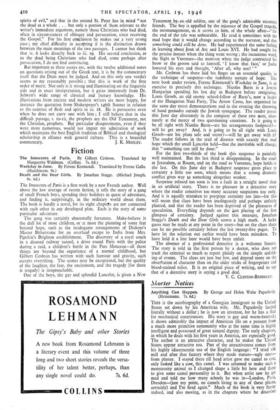First Epistle of St. Peter
The First Epistle of St. Peter. The Greek Text with Introduction.
Notes and Essays by Edward Gordon Selwyn, D.D. (Macmillan. 25s.) JUST over eighty years ago J. B. Lightfoot started the Macmillan series of Commentaries on the books of the New Testament with his Galatians. It is a series of which any publishing house might be proud, and its high standard is well sustained by the present volume, in which the Dean of Winchester brings this enterprise near to its end.
In his book, The Primitive Church, Dr. Streeter described the first Epistle of Peter as "one of the finest things in the New Testament." With " a pang " he decided against the Petrine author- ship and gave reasons for his suggestion that the author was a certain Aristion, to whom the second century writer Papias referred as. a disciple of the Lord. Of this conjecture of Streeter's the Dean makes no mention, but into the problem he goes very fully. Paying special attention to Silvanus, " through whom," the author says, he has briefly written, and to the parallels between I Peter and 1 and 2 Thessalonians, where Silvanus appears in association with St. Paul, Dr. Selwyn comes to the conclusion, stated in his note on v. 12, that the epistle " was the joint work of Silvanus and St. Peter, the fornher supplying the literary composition, much of it gathered from the common tradition, the latter providing the Apostolic testimony to the underlying facts of the Gospel and their application to the readers' condition." The internal evidence pointing. to
times inclined Peter's authorship is well presented. The Dean is at mes inclined to be more confident than cautious ; but his confidence is not in the air. Its grounds are visible, as when on v. I he argues that the words about sharing in the glory that is to be revealed refer to an actual experience, namely St. Peter's at the Transfiguration.
I have quoted the sentence in which Dr. Selwyn speaks of " the common tradition." One of the outstanding facts and values of this book is the way in which the .epistle is linked up with the whole movement of Christianity in the first century. The second long essay of just over too pages goes into this matter with a thoroughness and minuteness, in a survey of the New Testament epistolary literature, which will be of great service to all close students of that literature, and will impress all readers by the evidence it gives of the most careful attention to the documents. If the argument is approved by New Testament scholars it will result in a much greater hesitation in ascribing the likeness of one document to another to direct dependence, and in the recognition that " we have to account for a much larger and more complicated series of data than any series of direct dependence are sufficient of themselves to explain." Broadly speaking, the argument points to the existence of much common catechetical material in the primitive Church, dealing with the Christian life and its duties and with various personal relationships, on which the letter-writers drew. The other long essay is devoted to a detailed examination of the passages in the epistle's third and fourth chapters, where it is said that Christ went and preached, or made proclamation, to the spirits in prison, and that the Gospel was preached, or that Christ was preached, to the dead. Dr. Selwyn's conclusion is that in the first passa.te the reference is probably not to dead men but to "archetypal spirits of evil," and that in the second St. Peter has in mind " not the dead as a whole . . . but only a portion of them relevant to the writer's immediate argument, namely those Christians who had died, often in circumstances of obloquy and persecution, since receiving the Gospel." For his first conclusion he makes out a very strong case ; my chief difficulty in accepting ii is the distinction drawn between the main meanings of the two passages. I cannot but think that iv. 6 looks diredtly back to iii. 19. His second conclusion, as to the dead being Christians who had died, some perhaps after persecution, I do not find convincing.
But important as these essays are, with the twelve additional notes on questions arising out of the Greek text, it is by the commentary itself that the Dean must be judged. And on this only one verdict seems to me reasonably possible ; that this is work of the first order of merit. Not only is it strong and illuminating on the linguistic side and in exact interpretation, but it gains immensely from Dr. Selwyn's wide range of classical and literary knowledge. His illustrations from ancient and modern writers are most happy, for instance the quotation from Shakespeare's 146th Sonnet in relation to the contrast of flesh and spirit in iii. 18. He is persuasive even when he does not carry one with him ; I still believe that in the difficult pissage, i. 10-12, the prophets are the Old Testament, not the Christian, prophets. But particular disagreements, even if they were more numerous, would not impair my admiration of work which maintains the best English tradition of Biblical and theological scholarship in alliance with general culture. This is a beautiful































 Previous page
Previous page